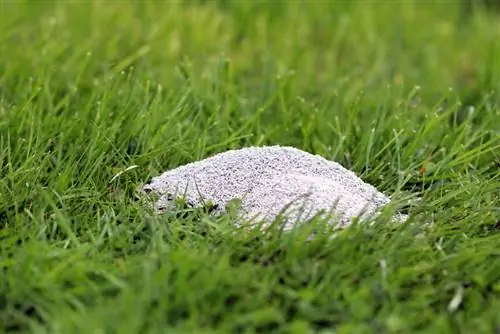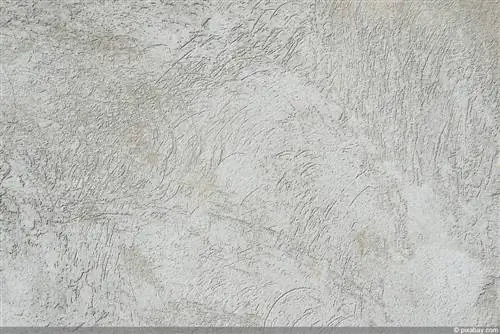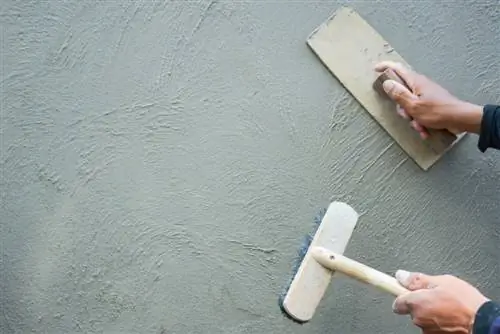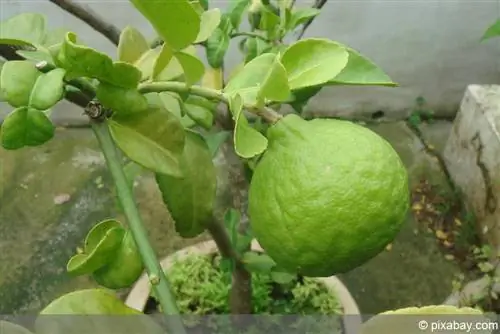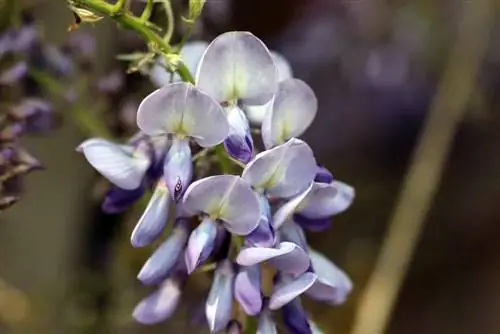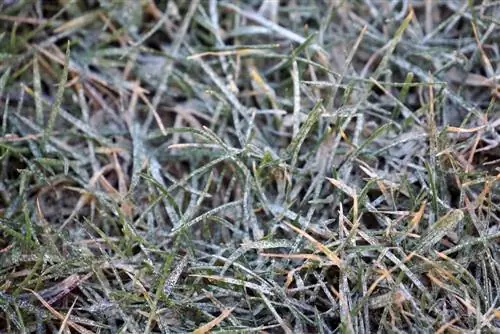- Author admin [email protected].
- Public 2023-12-17 03:39.
- Last modified 2025-06-01 06:48.
Lime fertilizer is an efficient additive for improving the soil in the garden. It works against soils that are too acidic and adjusts the pH value so that the lawn and other garden inhabitants can grow he althily. A popular and particularly gentle variant of lime fertilizer is garden lime, which can be used in a variety of gardens and offers the best conditions for the plants there.
Lime in the garden: what for?
Soils naturally have different pH values and are therefore not ideal for every plant. In order to improve unfavorable soils, they are optimized with the addition of different substances. Lime is used in the same way and helps raise the pH of the soil when it is too acidic. Even neutral soils can be protected from acidification with a small amount of lime, as in the humid, Central European climate the soil gradually becomes more acidic over time. Lime has the following effect on the soil:
- The nutrient supply to the plants is optimized
- Soil can store nutrients and moisture more effectively
- Soil warms up faster in spring
- It counteracts the mudding of lawns and plant beds
- Plants are supplied with more calcium
- Calcium leads to resistance to diseases in plants
These are the positive properties of all lime fertilizers, but not all variants can be used in the garden due to their direct effect on the soil and the environment. In order to be able to enjoy the benefits of lime fertilization in a gentle way, you should rely on garden lime.
Tip:
Please note that lime fertilizers should not be used if you have plants in the garden that require acidic soil. These include, for example, rhododendrons, camellias, hydrangeas or heathers.
Check soil
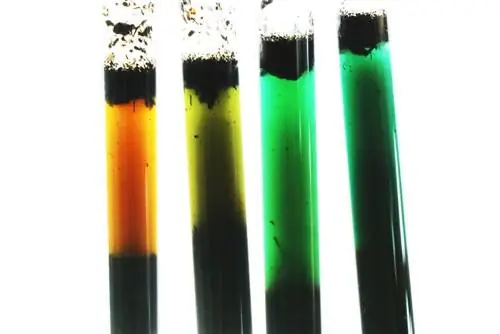
Before you can start liming, you need to check whether there is even a need for it. If you add too much garden lime to the soil without checking, you could run the risk of the existing humus in the soil being broken down. This could leach out the soil, which is unfavorable for the plants, as the excess amount of lime can have a negative impact on the soil's nutrient balance. For this reason, it is important to determine whether your garden soil is too acidic. This can be achieved using the following signs and methods.
Soil analysis
A soil analysis provides information about the composition of the soil and whether it is acidic, neutral or alkaline. If you are unsure whether your soil is in the ideal range, you should test it in one of three ways:
- pH measuring device: costs between 10 - 30 euros
- Test set: costs between 5 - 20 euros
- professional soil analysis in the laboratory: costs between 30 - 70 euros
The pH meter, like the test set, can be found in hardware stores, garden centers and on the Internet and offers a thorough analysis of the pH value of the soil. If you want to be more precise, you should send soil samples to a laboratory near you and have the substrate tested. This means you know exactly whether you need to lime.
Indicator plants
If the soil is too acidic over a long period of time, the following indicator plants will settle there:
- Moose
- Field horsetail (bot. Equisetum arvense)
- Hare clover (bot. Trifolium arvense)
- Sand pansy (bot. Viola tricolor)
- Small sorrel (bot. Rumex acetosella)
- Field chamomile (bot. Anthemis arvensis)
- Field Spörgel (bot. Spergula arvensis)
If you have not sown these plants yourself, the soil has become acidic and you must definitely use garden lime to compensate for this condition. If the settlement of the individual species is quite extensive, the suspicion of acidic soil increases.
Deficiencies
Classic deficiency symptoms such as yellowed leaves, dried shoot tips and brownish spots on the flesh indicate hyperacidity. Please note that these deficiency symptoms can also occur if there is too much moisture or waterlogging in the garden. Lawns and beds that receive little sun throughout the day tend to retain more water, which can also weaken plants if excessive watering or heavy rainfall occurs.
Best time

If it turns out that your soil needs to be improved with lime, the timing is crucial so that you don't lime at the wrong time or too often. Otherwise, the garden lime cannot work sufficiently in the soil or the decomposition of humus begins. In addition, this means you don't use too much of the additive. It is best to lime according to these guidelines:
- Time: early spring to the end of March
- Soil should be frozen but dry
- overcast skies are ideal
- sunny days should be avoided
If you can't manage to lime in spring, you should definitely use the garden lime in autumn (October). The only thing that matters here is that it is a little cooler so that the lime can work properly in the soil. Nevertheless, spring should be used as many plants often have difficulty absorbing nutrients from the soil due to the increased amount of moisture in the soil and this is regulated.
Maintenance liming
Maintenance liming is an important process that should be used even on soils that do not actually need to be limed. Here, the soil is enriched with garden lime under the same conditions every two to three years, depending on the acidity, so that the calcium that is washed out and absorbed by plants is replaced. This protects the soil from natural acidification, which occurs due to a lack of calcium and affects all soils in Germany. Make sure that the entire amount of garden lime that you would use for spring or fall liming is distributed over the year. This means you use half the amount of lime in March and the other half in October.
Use garden lime
The use of garden lime consists of the correct dosage and distribution of the substance. This allows the mineral to be evenly distributed without adding too much lime to the soil. Loamy soils in particular need to be limed, because clay soils that are too acidic have a negative effect on the growth of plants and can even poison them. Because too much acid dissolves the clay minerals in the clay, aluminum s alts are released, which accumulate more and more over time, causing problems in the growth of plants.
Dosage

No matter whether you are liming for the first time or using maintenance liming, the right amount of garden lime is crucial for success. For this you first need the land values. You can use these to check how acidic your soil is. After checking, dose as follows:
- slightly acidic soils (pH value of 6 - 7): 150 g per m²
- acidic soils (pH value of 5.5 - 6): 200 g per m²
- sandy soils: 250 g per m²
- loamy soils: 500 g per m²
Slightly acidic soils are usually supplied with the important mineral through maintenance lime, while soils that have a high proportion of sand and clay require fertilization more frequently and with much more garden lime.
Distributing garden lime: instructions
Distributing the garden lime is not difficult, but it may take longer depending on the area. Large lawns in particular must be supplied with plenty of lime as they are often heavily used. Liming in detail:
- Before spreading the garden lime, you should prepare the soil. To do this, loosen the area to be limed and remove weeds and plant residues. Here it is worth using the scarifier as it makes the work much easier.
- Then distribute all the lime and follow the dosages mentioned above for the different soil values. For a slightly acidic lawn area of ten square meters, you will need 1,500 grams of garden lime, which you can distribute either by hand or with a spreader.
Tip:
You don't need to worry, garden lime is completely harmless and can easily be touched with your free hand.

